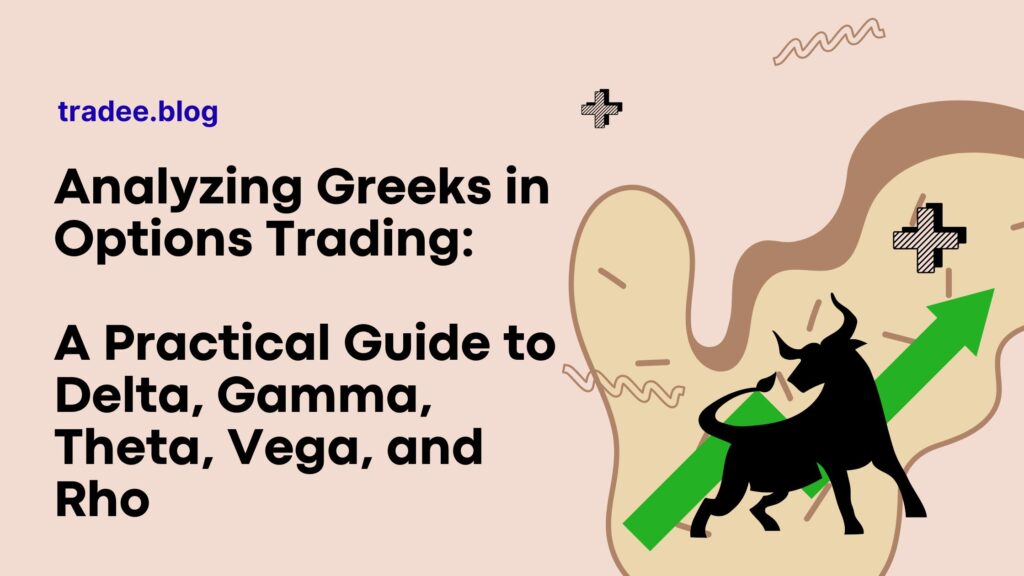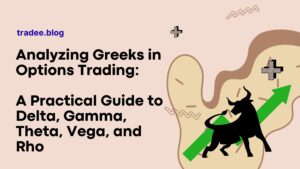Ever wondered how the pros really keep track of all the moving parts in options trading? The secret sauce isn’t just fancy math—it’s the Greeks!
Think of them as the dashboard of your trading “vehicle,” with each gauge showing how your option reacts to market twists and turns. For today’s ride, I’ve even put together an interactive app where you can tweak the numbers yourself.
Let’s pop the hood and learn how Delta, Gamma, Theta, Vega, and Rho can change your whole approach.
The Greeks: Your Trading Dashboard at a Glance
Imagine you’re driving a car. You’d never speed down the highway without checking the speedometer, right? Well, options traders rely on the Greeks the same way—except instead of speed and gas, you’re tracking risk, reward, and how your trades might behave as markets shift.
Delta (Δ): Your Directional Compass
Delta is the Greek that answers: “If the stock price goes up $1, what happens to my option?” For calls, delta ranges from 0 to +1; for puts, it’s 0 to -1. At-the-money options usually have a delta near 0.50. Here’s a cool tip: Delta also acts like a probability guide. A call with a delta of 0.70 usually means about a 70% chance of ending in-the-money.
Real-life scenario:
Suppose you’ve got a call with a delta of 0.65. If the stock jumps $1, your call should—in theory—gain $0.65 in value. Pro traders obsess over delta to stay balanced. If you’re short 1,000 calls with a delta of 0.50 each, buying 500 shares of the stock gets you to “delta-neutral”—you’re essentially balanced against small moves.
Gamma (Γ): The Acceleration Factor
If delta shows your “speed,” gamma tracks how fast your speed changes—your “acceleration.” Gamma measures how much delta will change if your stock moves by a buck.
Why does it matter?
Gamma peaks for at-the-money options close to expiry—that’s when options can go from zero to sixty. If you’re holding an ATM option in its final days, gamma can cause wild swings in your delta, which means profits (or losses!) can amplify almost instantly.
Quick example:
An option with a delta of 0.50 and gamma of 0.10: a $1 move in the stock nudges delta up to 0.60. In the final days before expiry, this can create dramatic, exciting (and sometimes scary) P&L swings.
Theta (Θ): The Silent Profit Killer
Theta is your reminder that time is always ticking. It tells you how much value your option loses every single day—just because the clock is running. If you own (buy) options, theta is usually your enemy. If you sell options, it’s your best friend.
Key tips:
Theta is always negative for long options. You’re losing a little value, daily.
For sellers, theta is positive—you’re collecting premium as time ticks by.
Time decay accelerates dramatically in the last 21–30 days before expiry. That’s “theta acceleration” and pro-traders LOVE it for strategies like iron condors or credit spreads.
When does theta hit hardest?
Right before expiration, especially for ATM options—so mind the calendar!
Vega (ν): The Volatility Barometer
Here’s where options trading gets spicy. Vega shows you how much your option price moves if implied volatility (IV) changes by 1%. It’s crucial around big events: earnings, central bank meetings, or crazy news cycles.
How does it work?
If vega is 0.20 and IV jumps by 5%, your option should increase by $1 (0.20 × 5).
Longer-dated and at-the-money options have the highest vega—so if you’re anticipating volatility, that’s where you want to be.
Why use vega?
Savvy options traders look for premiums before announcements (when IV shoots up), then might sell them once the dust settles and premiums fall.
Rho (ρ): The Interest Rate Gauge
Rho doesn’t always make headlines, but it matters when interest rates start moving—particularly for longer-dated options (think LEAPS).
Key points:
Rho is positive for call options (higher rates = higher price); negative for puts.
It matters most for trades with months (or years) left to expiration.
Day to day, rho is a small piece of the puzzle—but during rate hikes or cuts, it’s worth having on your radar.
Putting All the Greeks Together: Advanced Applications Made Simple
Now that you know what each Greek does, let’s look at why pros watch them together:
Delta Hedging
This is all about staying “market neutral.” For example, short 100 call options with a 0.60 delta? Buy 60 shares of the underlying. As delta shifts, you rebalance. It’s a staple move for many institutional traders.
Theta Decay Strategies
Want to make money as time ticks away? Structure spreads or iron condors with 30–45 days to expiry. You’re aiming to sell options when decay is picking up steam but you can still manage positions safely.
Vega Moves Around Events
Big announcement coming? Traders snap up high-vega, at-the-money options expecting an IV pop—then, post-event, those options might lose value as volatility “deflates.”
Risk Management: Don’t Just Watch the Dials—Act On Them!
A truly advanced trader uses all the Greeks to size up risk. High delta and high gamma? Buckle up for wild swings. Crazy theta? Time’s working for or against you. The real power lies in combining Greeks—hedge one with another to smooth out the bumps.
Pro traders also track their portfolio Greeks—the sum total across every option position. That helps them spot where they’re overexposed and keeps the risk in check, even as the market throws curveballs.
Wrapping Up: From Speculator to Strategist
Learning the Greeks isn’t just for math majors. Grasp these basics, and you instantly become a more strategic, risk-aware trader. Whether you’re hedging your bets, capturing theta, or riding a volatility wave, you’ll know exactly what risk you’re taking—and why.
So next time you put on an options trade, don’t just hope it’ll work out. Check your Greeks, know your dashboard, and drive your trading with confidence.
Happy trading!






